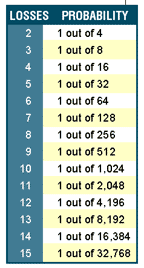MONEY MANAGEMENT
Conquer The Monster Of Ego, Fear, Greed, And Hope
Plan To Win
by Richard Ahrens
There are two kinds of traders: amateurs and professionals. The amateurs supply the money. Which would you rather be?
It has been estimated that only 10% of traders consistently make money. It has also been estimated that only 10% of traders have a clearly defined trading plan. Coincidence? Not likely. In the same way that a good builder must plan many different aspects of his or her project before beginning construction, a good trader must consider a variety of factors before entering a trade. Failing to consider all the elements of a trade may not lead to ruin, but it certainly stacks the odds against you. It's much better to have a complete plan in place for each trade before you put money on the table. So what factors do you need to consider when creating your trading plan?
CONSIDER THESE FACTORS
At a minimum, you need to determine:
1 - What and when to buy or sell
2 - Why you think this trade has potential
3 - What to do if the trade goes against you
4 - What to do if the trade goes for you
5 - How much to risk.
If you don't know the answers to these questions, you do not have a complete
plan, and you are not ready to enter the trade. (For the sake of simplicity,
I am only discussing long positions. But remember that a successful trader
does not favor long positions over short and instead allows the market
tell him or her which direction to trade.) Let's take a look at each of
these elements.
WHAT AND WHEN TO BUY OR SELL
Your choice of what to buy may be made on fundamental criteria, technical conditions, or a combination of the two. Unfortunately for some traders, making this initial decision is as far as their "planning" goes. They forget that profitability is the result of a good exit. A good entry only gives a trade the potential to make a profit: it takes both a buy and a sell to put money in your pocket.

Figure 1: Probability table of a system with a 50/50 win-loss ratio. There's a chance of seeing 13 or 14 losses in a row.
Of course you will try to choose an entry method that can identify potentially
profitable opportunities, but whatever method you choose, it should be
applied consistently. If it turns out the method is not working, then it
is time to withdraw from trading long enough to understand what is going
wrong and how to fix it.
...Continued in the May 2002 issue of Technical Analysis of STOCKS & COMMODITIES
Excerpted from an article originally published in the May 2002 issue of Technical Analysis of STOCKS & COMMODITIES magazine. All rights reserved. © Copyright 2002, Technical Analysis, Inc.
Return to May 2002 Contents